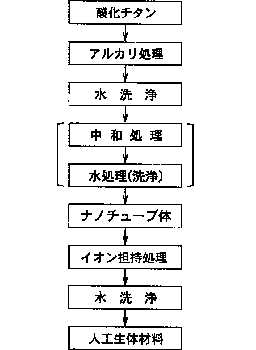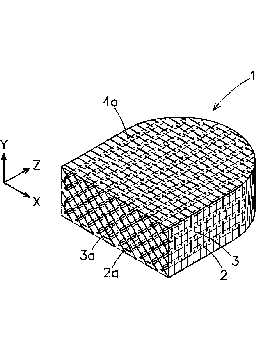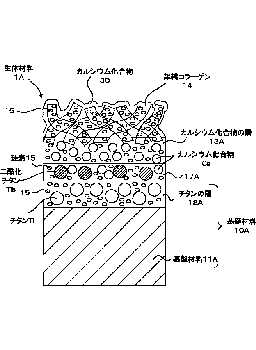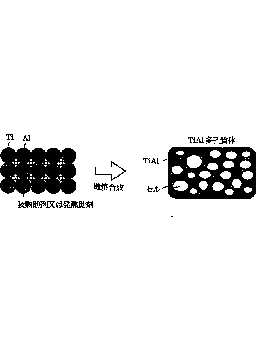
Biomaterials Patents - 2002 | 2003
TABLE OF CONTENTS
- CALCIUM PHOSPHATE-BASED BIOMATERIAL CONTAINING CALCIUM CARBONATE
- COMPOUND BIOMATERIAL CONTAINING PHOSPHO-FOLIN
- ARTIFICIAL BIOMATERIAL
- BIOMATERIAL FOR ARTIFICIAL CARTILAGE AND ITS MANUFACTURING METHOD
- BIOMATERIAL AND METHOD OF MANUFACTURING THE SAME
- CROSSLINKING COMPOSITE BIOMATERIAL
- METHOD FOR MANUFACTURING POROUS INTERMETALLIC COMPOUND OR CERAMICS
CALCIUM PHOSPHATE-BASED BIOMATERIAL CONTAINING CALCIUM CARBONATE
| (11)Publication number : | 2003-300806 |
| (43)Date of publication of application : | 21.10.2003 |
| (51)Int.CI. |
A61K 6/033 A61K 6/08 A61L 27/00 |
| (21)Application number : | 2002-110287 | (71)Applicant : | MARUO CALCIUM CO LTD |
| (22)Date of filing : | 12.04.2002 | (72)Inventor : | KON MASAYUKI ASAOKA KENZO LUCIANA M HIRAKATA MIYAMOTO YOJI |
|
Abstract: PROBLEM TO BE SOLVED: To provide a calcium phosphate-based biomaterial excellent in mechanical properties, an affinity for organisms and biofunctional properties (e.g. osseous conduction ability). SOLUTION: This calcium phosphate-based biomaterial comprises a calcium phosphate-based compound containing calcium carbonate having 1-50 aspect ratio (crystal length/crystal width). |
COMPOUND BIOMATERIAL CONTAINING PHOSPHO-FOLIN
| (11)Publication number : | 2003-235953 |
| (43)Date of publication of application : | 26.08.2003 |
| (51)Int.CI. |
A61L 27/00 |
| (21)Application number : | 2002-041409 | (71)Applicant : | NATIONAL INSTITUTE OF ADVANCED INDUSTRIAL & TECHNOLOGY |
| (22)Date of filing : | 19.02.2002 | (72)Inventor : | UEMURA JIYUKO TATEISHI TETSUYA SAITO TAKASHI IESHIMA DAISUKE |
|
Abstract: PROBLEM TO BE SOLVED: To obtain a low-priced artificial bone material having an excellent bioadaptability and the bone forming ability (bone formation inducing ability). SOLUTION: This artificial bone material is obtained by culturing a bone marrow-derived cell on a compound biomaterial having a sponge structure containing phospho-folin and collagen. |
ARTIFICIAL BIOMATERIAL
| (11)Publication number : | 2003-220127 |
| (43)Date of publication of application : | 05.08.2003 |
| (51)Int.CI. |
A61L 27/00 // C01G 23/04 |
| (21)Application number : | 2002-022310 | (71)Applicant : | CHUBU ELECTRIC POWER CO INC |
| (22)Date of filing : | 30.01.2002 | (72)Inventor : | KASUGA TOMOKO MASUI KAZUNORI HIRAMATSU MASAYOSHI |
 Abstract:
Abstract:PROBLEM TO BE SOLVED: To provide artificial biomaterials having a high biological activity and ability to be bonded with natural bones in a shorter period compared with conventional materials. SOLUTION: These artificial biomaterials are composed entirely or mainly of a nanotube body comprising titanium oxide and/or titanium oxide based double oxides. In particular, the material carrying a metal ion such as calcium ion thereon is excellent in the bone-forming ability. |
BIOMATERIAL FOR ARTIFICIAL CARTILAGE AND ITS MANUFACTURING METHOD
| (11)Publication number : | 2003-210499 |
| (43)Date of publication of application : | 29.07.2003 |
| (51)Int.CI. |
A61F 2/38 A61F 2/44 A61L 27/00 |
| (21)Application number : | 2002-013674 | (71)Applicant : | TAKIRON CO LTD |
| (22)Date of filing : | 23.01.2002 | (72)Inventor : | TSUTA KAORU |
 Abstract:
Abstract:PROBLEM TO BE SOLVED: To provide biomaterial for an artificial cartilage and a method of manufacturing the biomaterial showing deformation behavior approximate to a cartilage, describing a J-type stress-strain curve when compressive force and tensile force are applied thereto. SOLUTION: This biomaterial 1 for the artificial cartilage is formed of a triaxial and three-dimensional woven texture body woven and knitted with organic yarn and constituted by laminating V-axis yarn array layers 2 formed of endless folding arrangement of V-axis yarn 2 meandering in an oblique V-axis direction to an X-axis and a Y-axis within an X-Y plane, and W-axis yarn array layers 3 formed of endless folding arrangement of W-axis yarn 3a meandering in a reverse oblique W-axis direction, alternately in multilayers in a Z-axis direction, and caulking-connecting the array layers 2, 3 by Z-axis yarn 4a of endless folding arrangement piercingly meandering in the Z-direction. The biomaterial may be formed of a four-axis and three-dimensional woven texture body formed by laminating the V-axis yarn array layers, the W-axis yarn array layers, and X-axis yarn array layers or Y-axis yarn array layers of endless folding arrangement meandering in an X-axis or Y-axis direction, alternately in multilayers and caulking-connecting them by Z-axis yarn. Such a biomaterial is manufactured by a manufacturing method comprising a laminating process of the array layers, a clamping process and a caulking-connecting process by the Z-axis yarn. |
BIOMATERIAL AND METHOD OF MANUFACTURING THE SAME
| (11)Publication number : | 2002-369875 |
| (43)Date of publication of application : | 24.12.2002 |
| (51)Int.CI. |
A61L 27/00 |
| (21)Application number : | 2001-180924 | (71)Applicant : | YAMASHITA KIKUJI YAMASHITA TAKAHIRO |
| (22)Date of filing : | 15.06.2001 | (72)Inventor : | YAMASHITA KIKUJI |
 Abstract:
Abstract:PROBLEM TO BE SOLVED: To provide a biomaterial which has calcification ability, has high bioaffinity and strength, is usable for living organism and is easily disposable when used for other purposes than for the living organisms and a method of manufacturing the same. SOLUTION: This material is used by being embedded into the living organism and is composed by forming a layer 13 of a calcium compound on the surface of a foundation material 10 and bonding crosslinked collagen 14 to the surface of a layer of the calcium compound of the foundation material 10. Even if, therefore, the foundation material 10 is any material, the bioaffinity can be improved. Even more, the crosslinked collagen 14 is bonded to the surface of the layer 13 of the calcium compound and since the bioaffinity of the biomaterial 1 can be thereby further enhanced, the adverse influence to be exerted on the living organism when the material is embedded into the living organism can be prevented. |
CROSSLINKING COMPOSITE BIOMATERIAL
| (11)Publication number : | 2002-143290 |
| (43)Date of publication of application : | 21.05.2002 |
| (51)Int.CI. |
A61L 15/64 A61L 27/00 |
| (21)Application number : | 2000-349084 | (71)Applicant : | NATIONAL INSTITUTE OF ADVANCED INDUSTRIAL & TECHNOLOGY |
| (22)Date of filing : | 16.11.2000 | (72)Inventor : | CHIN KUNIHEI TATEISHI TETSUYA USHIDA TAKASHI |
|
Abstract: PROBLEM TO BE SOLVED: To obtain a new crosslinking composite biomaterial which exhibits excellent bioabsorbability and biocompatibility, is excellent in dissemination of cells and clinical handling property, has enough mechanical strength, is useful for regenerating or restructuring a covering material for skin wound such as skin ulcer and burn, or a skin tissue or living tissue or an internal organ such as ligament, bronchi and intestials, and provide an advantageous method for manufacturing the crosslinking composite biomaterial. SOLUTION: This biomaterial comprises a bioabsorbable synthetic polymer mesh body and a tissue-derived natural polymer porous body. The mesh body is made of a cloth, a woven fabric or an unwoven fabric, and a bioabsorbable synthetic polymer is formed from polylactic acid, polyglycolic acid or a copolymer of lactic acid with glycolic acid. The tissue-derived natural polymer is at least one kind selected from among collagen, gelatin, fibronectin or laminin. After treated in a tissue-derived natural polymer solution, the mesh body is freeze-dried, and the generated composite biomaterial is treated with a gaseous chemical crosslinking agent. |
METHOD FOR MANUFACTURING POROUS INTERMETALLIC COMPOUND OR CERAMICS
| (11)Publication number : | 2002-097531 |
| (43)Date of publication of application : | 02.04.2002 |
| (51)Int.CI.
C22C 1/08 B22F 3/11 C04B 38/00 C22C 1/10 |
| (21)Application number : | 2000-291508 | (71)Applicant : | JAPAN SCIENCE & TECHNOLOGY CORP |
| (22)Date of filing : | 26.09.2000 | (72)Inventor : | KANETAKE NAOYUKI KOBASHI MAKOTO CHO TAKAO |
 Abstract:
Abstract:PROBLEM TO BE SOLVED: To provide porous intermetallic compounds or ceramics useful for a filter for cleaning waste gas, an impact absorption member, a heat insulating and sound absorbing material, biomaterial and the like. SOLUTION: This method for manufacturing the porous intermetallic compounds or ceramics comprises mixing different kinds of metal powders according to a composition in manufacturing the intermetallic compounds or the ceramics, forming them with combustion synthesis, and making them porous by means of generating bubbles of gas components absorbed or occluded in the metal powders, during the combustion synthesis. Pore size or porosity of the porous intermetallic compound or the ceramics is controlled by a mixing rate of a raw material powder, a compression ratio of the mixed powders, a heat quantity on preheating and the combustion synthesis, and an addition of exothermic or endothermic auxiliaries. |